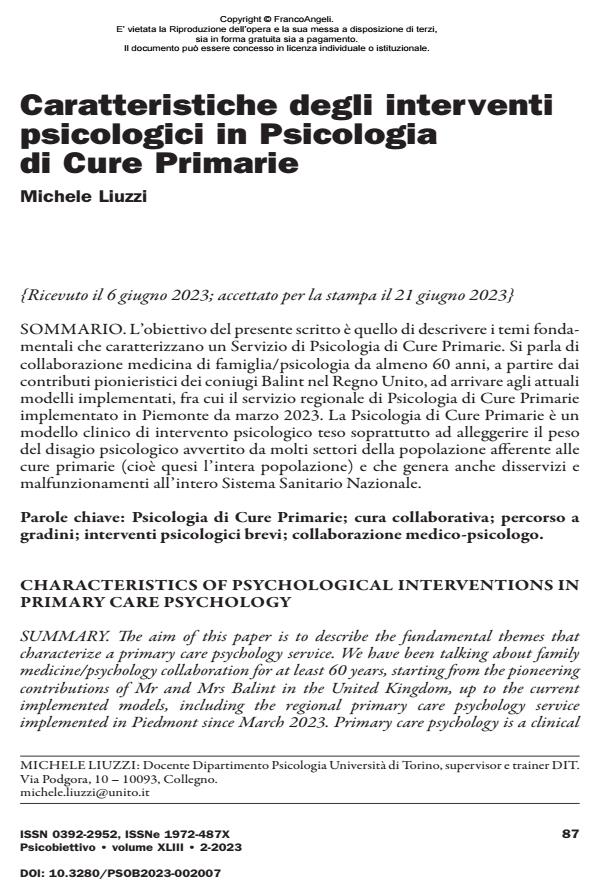Characteristics of psychological interventions in primary care psychology
Journal title PSICOBIETTIVO
Author/s Michele Liuzzi
Publishing Year 2023 Issue 2023/2
Language Italian Pages 12 P. 87-98 File size 630 KB
DOI 10.3280/PSOB2023-002007
DOI is like a bar code for intellectual property: to have more infomation
click here
Below, you can see the article first page
If you want to buy this article in PDF format, you can do it, following the instructions to buy download credits

FrancoAngeli is member of Publishers International Linking Association, Inc (PILA), a not-for-profit association which run the CrossRef service enabling links to and from online scholarly content.
The aim of this paper is to describe the fundamental themes that characterize a primary care psychology service. We have been talking about family medicine/psychology collaboration for at least 60 years, starting from the pioneering contributions of Mr and Mrs Balint in the United Kingdom, up to the current implemented models, including the regional primary care psychology service implemented in Piedmont since March 2023. Primary care psychology is a clinical model of psychological intervention aimed above all at lightening the burden of psychological discomfort felt by many sectors of the population belonging to primary care (i.e. almost the entire population) and wich alsogenerates disservices and malfunctions to the entire national health system.
Keywords: primary care psychology; collaborative care; stepped care model brief psychological interventions; doctor-psychologist collaboration.
- Atun R. (2004). What are the advantages and disadvantages of restructuring a health care system to be more focused on primary care services? Copenhagen, WHO Regional Office for Europe.
- DoH (2003). Fast-forwarding primary care mental health, Department of Health, Crown Copyright, London.
- DoH (2008). Commissioning IAPT for the whole community. Improving Access to Psychological Therapies (IAPT). Department of Health, Crown Publications, London.
- Elder A. (2009). The GP surgery as a secure base? Patterns of attachment in primary care. Psychodynamic Practice, 15(1): 57-70.
- Gunn W., Blount A. (2009). Primary care mental health: a new frontier for psycho- logy. Journal of Clinical Psychology, 65(3): 235-252.
- Kates N., Mazowita G., Lemire F. et al. (2011). The Evolution of Collaborative Mental Health Care in Canada: A Shared Vision for the Future. The Canadian Journal of Psychiatry, 56(5): 1-10.
- Katon W. (2012). Collaborative depression care models. American Journal of Preventive Medicine, 42(5): 550-552.
- Layard R., CEP Mental Health Policy Group (2006). The Depression Report: A New Deal for Depression and Anxiety Disorders. CEP Reports 15. Centre for Economic Performance, LSE.
- Liuzzi M. (2010). Psicologia di cure primarie. Milano: CIS Edizioni.
- Liuzzi M. (2016). La psicologia nelle cure primarie. Bologna: il Mulino.
- Richards D., Suckling R. (2009). Improving access to psychological therapies: Phase IV prospective cohort study, British Journal of Clinical Psychology, 48: 377-396. DOI: 10.1348/014466509X405178
- Strosahl K. (2001). The integration of primary care and behavioral health: Type II change in the era of managed care. In: Cummings N., O’Donohoe W., Hayes S., Follette V. (eds.). Integrated behavioral healthcare: Positioning mental health prac- tice with medical/surgical practice. New York: Academic Press.
- WHO (1990). The introduction of a mental health component into primary care. Geneva: WHO Publications.
- WHO (2008). Integrating mental health into primary care. A global perspective. Geneva: WHO Publications.
- WHO (2018). Mental health atlas 2017. Testo disponibile al sito: apps.who.int/iris/ handle/10665/272735.
Michele Liuzzi, Caratteristiche degli interventi psicologici in Psicologia di Cure Primarie in "PSICOBIETTIVO" 2/2023, pp 87-98, DOI: 10.3280/PSOB2023-002007